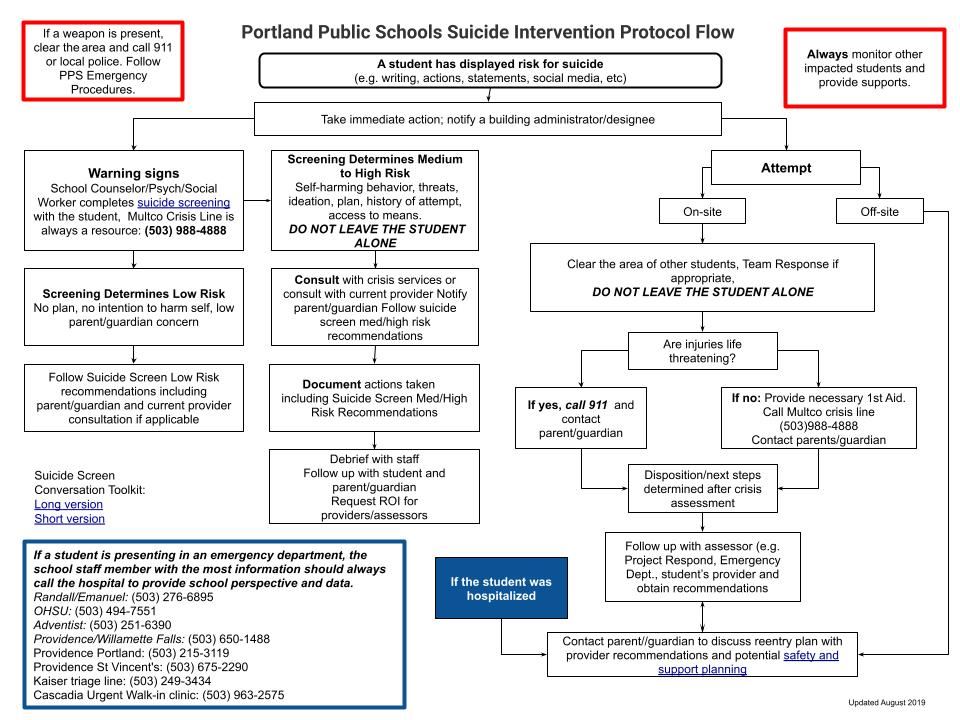Roosevelt Suicide Intervention Plan
-
School counselors, social workers, school psychologists, and administrators often become aware of a student who poses a risk for suicide through concerns brought to them by staff, other students, parents, or from direct referral by the student. A suicide risk screening needs to be completed for every student who demonstrates risk for suicide.
In the flowchart below, you will see the Portland Public School's Suicide Intervention Flowchart. This flowchart guides the response protocol at all PPS schools. Although each student is unique, the same steps apply to how we respond to risk for suicide. All students who display risk for suicide must be assessed by a qualified staff member. These staff members may be school counselors, school psychologists, qualified mental health providers (QMHPs), school social workers, or administrators. Every effort is made for the student to be assessed by a staff member that they feel connected to/comfortable with.

-
FERPA (Family Education Rights and Privacy Act)
School employees, with the exception of nurses and psychologists who are bound by HIPAA, are bound by the Family Education Rights and Privacy Act of 1974, commonly known as FERPA.
There are situations when confidentiality must NOT BE MAINTAINED; if at any time, a student has shared information that indicates the student is in imminent risk of harm/danger to self or others, that information MUST BE shared. The details regarding the student can be discussed with those who need to intervene to keep the student safe. This is in compliance with the spirit of FERPA and HIPAA known as “minimum necessary disclosure.”
When a Student Does Not Want to Share Information with Parents/Guardians
Many youth are often afraid to share information about their suicidal ideation with their parents or guardians. The fear may be that their family won't believe them, will say things like "you're just seeking attention", or that they will be shamed in other ways. However, the great majority of parents and guardians are empathetic to their child and the thoughts the child is having. They want to help.
If a student is concerned about their parent/guardian knowing about the suicidal thoughts they're having, the support staff they are working with should engage them in a conversation to get to the root of the fears and to assure them that the staff person is doing everything with the student's safety in mind. The school support staff can say something like “I know that this is scary to share this information with your parent/guardian but I need to know that you're safe and cared for when you leave school today. Telling your parent/guardian is the best way to make sure you have more people on your team that can help."
Exceptions to Sharing Information with Parents/Guardians
In most cases, school staff are required to share information about a student's risk for suicide with their parents/guardians. However, in cases of child abuse or neglect, the protocols for reporting abuse to DHS are followed. This may mean that in lieu of contacting parents/guardians, a phone call to DHS is warranted along with additional planning for safety with the student and other relevant adults.
-
Roosevelt High School Intervention Protocol
-
If a student displays risk for suicide, a suicide screening is conducted by an appropriate screener. This initial screening is designed to gather more information and assess the level of risk of suicide.
-
Once the initial screening has been completed, the screener consults with another trained staff member to determine the level of risk and if further assessment is needed. The screener can also consult with Student Success and Health staff and/or the Multnomah County Crisis Line.
-
If the risk is deemed low (no plan, no intention to harm self, low parent/guardian concern), a plan for follow up is created and the student/family are informed of options if the risk escalates. If the risk is deemed medium/high (self harming behavior, threats to die by suicide, ideation, a suicide plan, history of previous attempt(s), and/or access to means), staff document steps taken which may include informing family, encouraging student/family to receive emergency services at an emergency room or mental health urgent walk in clinic, and/or creating a plan for safety in and outside of school. All steps are documented and submitted to PPS' Student Success and Health.
-
All created safety plans will be followed up on within at least two weeks to ensure they are being followed and that listed supports are continuing to be helpful. Once the student has stabilized, a plan may be discontinued but can be reinitiated at any time.
All safety plans should be made with direct input from student. Our goal is to always place the student's needs first to ensure they have a support plan that they can/will follow and that will be most helpful to them in times of need.
If a Student is Hospitalized:
1. If an attempt was made and/or student was hospitalized, a school psychologist will be informed and involved to complete the federally mandated Child Find process and assess if Special Education services are needed for the student if/when they return to school.
2. All students who have been hospitalized for suicide attempts or in times of high risk when safety cannot be ensured MUST have a re-engagement meeting before returning to classes. This is done to make sure that support staff are aware of any safety plans and to allow time to coordinate supports with the student and family/guardian as well as any outside providers.
-



